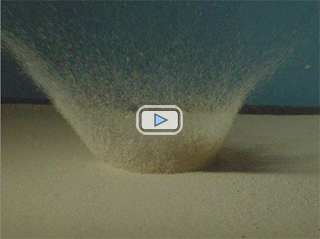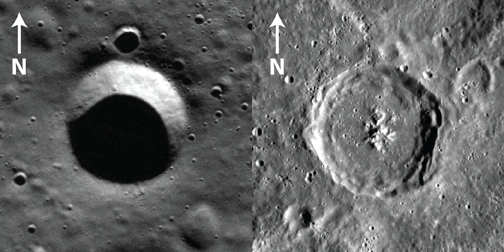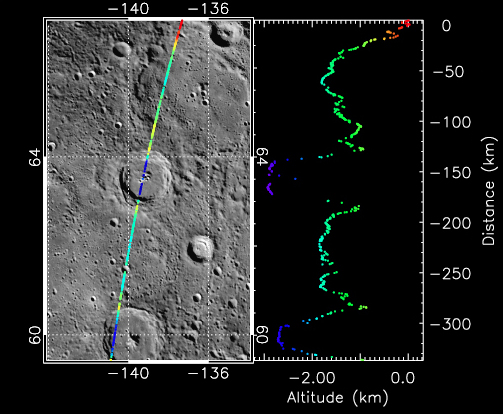July 7, 2011
Taking the Measure of Impact Craters on Mercury

Figure 1. This movie (600 frames per second) of a vertical impact made by a 1.5-cm-diameter glass projectile launched at ~50 m/s into playground sand shows many aspects of the cratering process that governs high-speed (~40 km/s) impacts on Mercury. Debris, or ejecta, is excavated as an inverted cone that moves radially outward, leaving behind an ejecta deposit, raised rim, and crater. (Courtesy of the JHU/APL Planetary Impact Laboratory.)
The sizes, shapes, and structures of impact craters on a planetary body provide information not only on the cratering history on that body but also on the nature and evolution of the planet’s surface. Such information is derived from knowledge of impact cratering physics together with measurements of crater dimensions and characterization of crater forms on a range of solar system objects. Studies of impact cratering physics rely primarily on two approaches: laboratory impact experiments (Figure 1 shows one example) and numerical simulations of the cratering process with analytical methods and computational codes. Impact experiments display the basic physics controlling the impact process, and numerical investigations permit the extrapolation of these findings to crater formation on planetary scales.
By comparing the dimensions of comparatively recent or fresh craters with those of older more degraded craters, it is possible to learn about the processes that modify a planet’s surface. In addition, much can be learned about the properties of a surface – such as the rock, ice, or soil proportion – from studying craters of different shapes and sizes. Such investigations are ongoing at Mercury with observations obtained by the MESSENGER spacecraft.
The study of craters on Mercury is particularly important because its surface gravitational acceleration (3.7 m/s2) is nearly identical to that at Mars. Gravity plays an important role in controlling the “transition diameter” below which smaller craters have a simple morphology and above which the morphology is more complex. Simple craters tend to be bowl shaped (Figure 2, left), whereas complex craters have terraced walls and can contain a central peak (Figure 2, right). If gravity were the dominant factor controlling the transition diameter, one would expect that this diameter would be similar on Mercury and Mars. The transition diameter observed on Mercury, however, at 10-12 km is ~1.8 times larger than that seen on Mars (6-8 km). This difference in transition diameter indicates that factors other than gravity are influencing crater morphology. Possible contributors include the velocity of the impactors that form the craters and the strength of near-surface material. The mean impact velocity on Mercury is 2-3 times greater than on Mars, and the Martian crust may be weaker than that of Mercury, for example, as a result of near-surface water ice.

Figure 2. Images of craters obtained by MDIS from orbit. Left: A simple, bowl-shaped crater 4.1 km in diameter crater located at 78.8ºN, 346.3ºE. Solar illumination is from the south. Right: A complex crater 51.5 km in diameter located at 2.3ºN, 121.4ºE. Illumination is from the east. Shadows cast on a crater interior can be used to estimate the depth of a crater floor below the surrounding rim.
The Mercury Laser Altimeter (MLA) and the Mercury Dual Imaging System (MDIS) provide the data needed to assess the sizes, shapes, and structures of impact craters on Mercury (Figure 3). MLA provides precise topographic profiles of crater floors, central peaks, and interior and wall slopes. The combined use of MLA and MDIS observations provides accurate measurements of crater diameters. For some of the smaller craters observed on Mercury, MDIS data alone may be used to determine crater depth by measuring the length of shadows cast by a crater’s wall onto its interior (Figure 2). MLA cannot always be used for these types of measurements because its ground track may not pass through the center of a small crater of interest, and the along-track spacing between MLA footprints (~800 m) may not permit the accurate measurement of the depth and diameter of a small crater. Differences in the ratio of crater depth to rim diameter between a degraded crater and a fresh crater of comparable size provides a measure of crater modification by the erosion and deposition that accompanied later nearby impacts. Similarly, if volcanic deposits have been emplaced within one crater, yet another of similar size has not been the site of volcanic flows, the depth-to-diameter ratios can be used to estimate the thickness of the volcanic deposits on the floor of the first crater.
As MESSENGER continues to orbit the innermost planet, new images and altimetry expand the possibilities for in-depth studies of Mercury’s craters on a daily basis. Those studies will further our understanding of the cratering process on Mercury and throughout the Solar System.

Figure 3. An example complex crater on Mercury, ~ 55 km in diameter and centered near 63.5°N, -139ºE, that has been imaged by MDIS (left) and profiled by MLA (right). A slightly larger complex crater lies along the MLA profile to the south.


